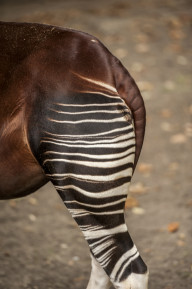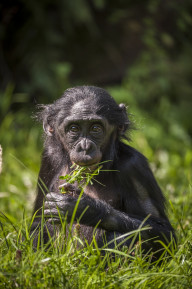Breeding programmes
Noah's Ark or perhaps not
One of the most important functions of modern zoos is to contribute to conservation. Population management or ex-situ breeding programmes for endangered species are one of the ways this is achieved. The animals born in captivity are sometimes used to boost populations in the wild but, in most cases, the aim of these programmes is to create a sustainable back-up population, or Noah's Ark, should the fortunes of the wild population really take a turn for the worse. In the same way that you make a back-up of your computer files. You hope you'll never need them but if your computer crashes, you're glad you have them. A second objective is to use these populations for educational purposes, to raise funds for conservation programmes and for scientific research. Ex-situ programmes are therefore set up not only for endangered species but also for species which are of great importance for their educational value and which, without intensive management, are at risk of disappearing from zoo collections. International collaboration and close coordination is crucial to this objective.
The scientists and animal care experts of Antwerp ZOO and Planckendael ZOO run ex-situ programmes for the okapi (Okapia johnstoni), the bonobo (Pan paniscus), the Congo peafowl (Afropavo congensis), the golden-headed lion tamarin (Leontopithecus chrysomelas) and the cinereous or Eurasian black vulture (Aegypius monachus).
International collaboration
An individual zoo can obviously not set up a breeding programme alone. This is always done in collaboration with other zoos; in our case, with fellow members of the European Association of Zoos and Aquaria (EAZA).
What is EAZA?
The number of individuals of any particular species that a zoo can keep is obviously limited. Such small groups of animals, like on Noah's Ark, could soon lead to such problems as inbreeding, loss of genetic variation, lack of space to keep the offspring, shortage of new breeding animals, and so on. However, if zoos collaborate internationally, coordinated animal exchange could minimise these challenges. Moreover, the animals are no longer traded but are usually loaned to other zoos. The majority even donated in fact, because financial transactions are strictly forbidden within EAZA. Furthermore, well-coordinated breeding results allow zoo populations to sustain themselves. That way, bringing animals in from the wild is seldom necessary.
The member zoos of the EAZA, which collectively breed and mutually exchange animals, agree which species to keep in their collections. These agreements are set out in a Regional Collection Plan (RCP). The regional collection plans are developed by 39 different Taxon Advisory Groups (TAGs), each of which comprises of a group of experts who monitor and advise on the species for which they are responsible. The Great Ape TAG, for example, is responsible for the four species of great apes: gorillas, chimpanzees, bonobos and orang-utans. Among other things, the RCP specifies how the population of each species can best be managed in a breeding programme. In the case of EAZA zoos, these are the EAZA Ex-situ Programmes (EEPs).
What is an EEP?
In practice, every zoo that is a member of EAZA is responsible for one or more EEPs. Each EEP has a coordinator who is assisted by a committee of experts, the 'Species Committee', and a studbook keeper. The studbook keeper records all the specific details of each individual animal in a studbook, such as its date of birth, who the parents are, the date it was moved between zoos, breeding partners, offspring, housing details, medical information, and so on. Nowadays, most zoos do this using the online Zoological Information Management System (ZIMS).
The coordinator then uses these studbook data and the PMx software to perform demographic and genetic analyses. A management plan is subsequently prepared with recommendations for the future. For example, the coordinator could determine which female could best be mated with which male, anywhere worldwide, to minimise both inbreeding and the loss of genetic variation in the population. That is the only way to ensure genetically and demographically healthy populations of endangered species. Breeding endangered species in zoos does not aim to replace the measures in place to protect these species in the wild. Zoos collaborate closely with conservationists. By collecting and sharing information, scientific knowledge, funding, materials, experience and expertise, both parties seek to collaborate towards the collective goal: the conservation of species in their natural habitats.
The EEPs managed by Antwerp ZOO And PlanckendaeL ZOO
The researchers and experts of Antwerp ZOO and Planckendael ZOO run EEPs for the okapi (Okapia johnstoni), the bonobo (Pan paniscus), the Congo peafowl (Afropavo congensis), the golden-headed lion tamarin (Leontopithecus chrysomelas) and the Cinereous or black vulture (Aegypius monachus).

As international studbook keeper and coordinator of the European population management programme, our curator Sander Hofman is responsible for advising on how the okapi in the EEP can best be managed.

The international breeding programme for this species is coordinated, on behalf of Planckendael ZOO, by our curator of mammals Sarah Lafaut and scientist Jeroen Stevens. In Planckendael ZOO our science team has been conducting scientific research with zoo-housed and wild bonobos for more than 25 years.

Our researcher Peter Galbusera and assistant curator Steven Vansteenkiste coordinate this programme on behalf of Antwerp ZOO. Sadly, breeding success with Congo peafowl has been very low and in some years the population even declined.

From Antwerp ZOO, our researcher Peter Galbusera coordinates the breeding programme of golden-headed lion tamarins and attemps to maintain as healthy a zoo population as possible. In Brazil, our researcher Kristel De Vleeschouwer leads our own conservation research project BioBrasil

Under the expert guidance of Marleen Huyghe, the cinereous vulture EEP focuses on optimizing the breeding succes of the species in zoos. In ZOO Planckendael a dating aviary was set-up where birds can choose their preferred partner. Scientist Philippe Helsen studies pair formation and breeding success in zoo-housed vultures and uses DNA analyses to evaluate rewilding programmes for the species.

